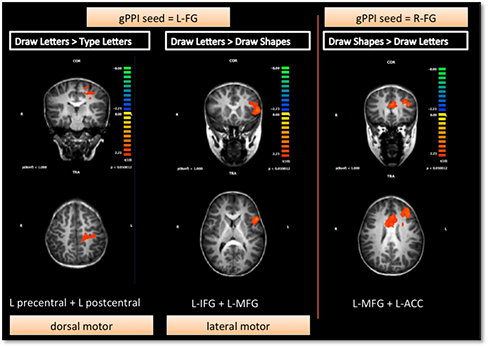The Cognition and Action Neuroimaging Laboratory

What are the effects of handwriting on cognitive development?
We have conducted several studies that document the effects that self-generated writing by hand has on functional brain development. This research began with several studies on adult letter perception, and has led to the following observations:
1) Motor systems in the brain are engaged during letter perception.
Vinci-Booher, S., Sehgal, N., Munoz-Rubke, F., & James, K.H. (2016, May). Perceptual and motor effects of letter writing on brain regions associated with letter perception. Poster presented at the Annual Meeting of the Vision Sciences Society, St. Pete Beach, FL. (PDF)
James, K.H. & Gauthier, I. (2006). Letter processing automatically recruits a sensory-motor brain network. Neuropsychologia, 44(14), 2937-2949.
2) Young children show adult-like brain responses to letters only after they learned to print letters, but not after learning letters through typing, visual study, or even tracing.
Vinci-Booher, S., Cheng, H., & James, K.H. (2016, March). Handwriting as a visually guided action: A developmental neuroimaging study. Poster presented at the Latin American School for Education, Cognitive, and Neural Sciences, Buenos Aires, Argentina.
Sehgal, N., Vinci-Booher, S., & James, K.H. (2015, February). The relationship between handedness and activation in the visual cortex of the brain. Poster presented at the Center of Excellence for Women in Technology Conference, Bloomington, IN.
Kersey, A. J. & James, K.H. (2013). Brain activation patterns resulting from learning letter forms through active self-production and passive observation in young children. Frontiers in Psychology, 4, Article 567.
doi: 10.3389/fpsyg.2013.00567
James, K.H. & Engelhardt, L. (2012). The effects of handwriting experience on functional brain development in per-literate children. Trends in Neuroscience and Education, 1, 32-42. doi:10.1016/j.tine.2012.08.001 (PDF)
James, K.H. (2010). Sensori-motor experience leads to changes in visual processing in the developing brain. Developmental Science. 13 (2), 279-288. doi:10.1111/j.1467-7687.2009.00883.x
3) The benefits of learning symbols through handwriting carries over into adulthood when we learn new scripts.
Frizell, T., Vinci-Booher, S., Zemlock, D., James, K.H., & Crandall, D.J. (2015, July). Exploring automated techniques for identifying and scoring children’s handwriting samples. Poster presented at the Summer Research Experience for Undergraduates Conference, Bloomington, IN.
James, K.H. & Atwood, T. (2009). The role of sensorimotor learning in the perception of letter-like forms: Tracking the causes of neural specialization for letters. Cognitive Neuropsychology, 26(1), 91-110.
doi: 10.1080/02643290802425914
4) This benefit may be partially due to the output of the motor act of writing – in the variable symbols that are produced when we first learn to print.
Li, J.X., James K.H. (2016) Handwriting generates variable visual input to facilitate symbol learning. Journal of Experimental Psychology: General. 145(3):298-313. doi:10.1037/xge0000134. (PDF)
Zemlock, D., Vinci-Booher, S., & James, K.H. (2016, April). Learning about letters through handwriting practice. Poster presented at The National Conference on Undergraduate Research, Asheville, NC.
5) Only printing experience functionally connects visual and motor networks in the developing brain
Vinci-Booher, S., Engelhardt, L., James, T.W., & James, K.H. (2014). Investigating the development of letter
perception using gPPI connectivity analysis. Presented at the Center of Excellence for Women in Technology
Conference, Bloomington, Indiana.
From Neural Substrates of Sensorimotor Processes: Letter Writing and Letter Perception. Journal of Neurophysiology, 115(1), 1-4. (PDF):
Only letters learned through printing experience, not typing, promote functional connections between a letter perception area in the left fusiform gyrus (L-FuG) with sensorimotor regions. Additionally, only letters learned through printing, not shapes learned through drawing, promote functional connections between the same letter perception area and premotor areas. On the other hand, the right hemisphere homologue, right fusiform gyrus (R-FuG), becomes more functionally connected with premotor areas for shapes learned through drawing, than letters learned through printing. Overall, sensorimotor and premotor areas show increased functional connectivity with left hemispheric letter perception areas for letters learned through printing. For more infomration, view doctoral student Sophia Vinci-Booher's research poster.

This body of work has led to numerous conference presentations, publications, and media attention: (click here to view full media page):
A TIME magazine article, "Are There Really Benefits to Writing Things by Hand?" includes Dr. James' research results and observations.
Dr. James' research on handwriting was featured in the September 21, 2014 edition of Parade Magazine.
How Does Handwriting Affect Brain Development? Dr. James explores this question on the September 19, 2014 edition of Sound Medicine, Public Radio's Weekly Magazine About Medicine and Health.
"Does handwriting matter?" Dr. James' work was part of the June 2, 2014 New York Times feature on the effects of the diminished emphasis on teaching handwriting skills to school children.
This handwriting research is highlighted in the IU Newsroom Fall, 2014 back-to-school-issue.
During the 2012 Handwriting in the 21st Century Educational Summit in Washington, DC, Dr. James presented some of her findings from this research. Watch her presentation.
On January 23, 2012, while at the Summit, Dr. James discussed the importance of handwriting in child development on the Fox News network affiliate in Washington DC. Watch the interview.
Dr. James was interviewed for a feature in STATEIMPACT INDIANA entitled "Why Schools Should Keep Teaching Handwriting, Even If Typing Is More Useful." (September 29, 2011)
Read the June 15, 2011 Chicago Tribune article, "The many health perks of good handwriting: Not only does it help the brain develop, it can also improve grades and confidence" which features Dr. Karin James.
This body of research was used to illustrate the benefits of handwriting in the Ocotober 5, 2010 Wall Street Journal article "Handwriting Trains the Brain." (October, 2010)

Cognition & Action Neuroimaging Lab | 1101 E. 10th Street, Bloomington, IN 47405 | (812)856-7237 | canlab1@indiana.edu